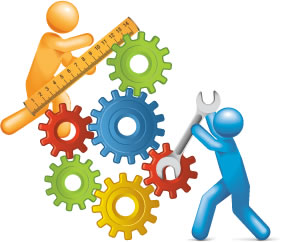Team science approaches have accomplished biomedical breakthroughs once considered impossible.
- Completion of the Human Genome Project
- Development of antiretroviral medications to control AIDS
- Discovery of the causative agent for Severe Acute Respiratory Syndrome (SARS)
- Successful development of the HPV vaccine
The collaboration of dedicated researchers from diverse disciplines and institutions has been critical to these achievements. While the increasing size of team-based research projects brings greater scientific expertise and more advanced instrumentation to a research question, it also increases the time required for communication and coordination of work. If these challenges are not recognized and addressed, projects may fail to achieve their scientific goals. Individual scientists must make decisions about whether to invest time and energy into collaborative projects or to focus on individual investigations.
While team science promises individual and team benefits in creating and implementing
innovations, adapting to the team science framework has been cited as one of the more difficult adjustments for academic organizations due to a variety of contextual environmental influences such as:
- Institutional infrastructure and resources for communication and data sharing
- Organizational policies—such as promotion and tenure policies—that impact team-based endeavors
- Team processes, including the existence of agreements related to proprietary rights to data and discovery, as well as mechanisms for feedback and reflection
- Team members' collaborative skills and experiences
- Interpersonal dynamics among team members
Interdisciplinary teams in team science represent a shift for the academic research culture which has typically supported distinct departmental structures and has valued individual effort for promotion and tenure of faculty. Increased complexity and high diversity of membership, deep knowledge integration, and high task interdependence all pose challenges for individuals and institutions. Junior faculty face several challenges in sharing recognition, credit, and power with senior faculty who are more established researchers. In particular, since academic career advancement commonly focuses on individual achievement, team science might negatively impact the career advancement of early stage researchers. Some efforts to establish norms for evaluating individual accomplishments in the context of a team effort have been made, but are less widely implemented. The need to be recognized for individual accomplishments in order to move forward in an academic career may give rise to research team conflicts.
Organizational change is needed to address these challenges. To advance team science and reap its benefits, systematic organizational change in education and training is needed. Faculty development at the system level can lead to organizational change, and can begin with a new vision for faculty development and new skill sets for faculty developers. Traditionally, faculty development is often treated as a service-oriented entity and considered as an end rather than a means to accomplishing important goals. Faculty development programs focus on personal mastery within the mission of the organization. Faculty developers are those who are good facilitators and conduct workshops and sessions focused on personal mastery. Personal mastery involves helping individuals achieve their maximum potential as educators, researchers, and patient care providers. In the era of team science, the position of faculty developer demands vision, creativity, and a take-charge attitude to bring systematic change by offering faculty development at micro (individual), meso (group), and macro (organizational) levels within institutions. Faculty developers must cultivate systems aimed at creating a common language focused on pedagogy. They must also work with leadership to create new policies, develop rewards and incentives for institutional missions, and establish institutional goals with respect to scientific collaboration. They must possess resilient organizational, communicative, and administrative skills, and must have the ability to take the lead in promoting a spirit of community among faculty, students, and administrators.
In this blog I wish to explore my view of faculty developers as agents of change. By taking a systematic approach to change, faculty developers are in the best position to help their institutions become learning organizations during the team science era.
I hope to foster dialogue by posing the following questions to those of you who serve as faculty developers:
(1) How do we take a stronger, proactive approach to help solve issues raised in the era of team science?
(2) What kinds of institutional change can we hope to bring about with a systematic approach?
Darshana Shah, PhD., is a Professor of Pathology and Associate Dean for the Office of Faculty Advancement at the Marshall University Joan C. Edwards School of Medicine. She is the founding Editor-in-Chief of the Marshall Journal of Medicine (MJM) and (added)serves on the board of International Network fo the Science of Team Science. She is a Harvard Macy Fellow, and currently participates as an invited faculty in the program for Leading Innovations in Healthcare & Education. Shah teaches a course on team science and also leads professional development in the field of team science for the West Virginia Clinical & Translational Science Institute. Darshana’ s areas of professional interest include faculty vitality and retention. You can follow her on LinkedIn or Twitter @DarshanaShah.





